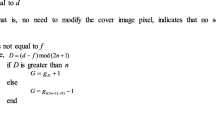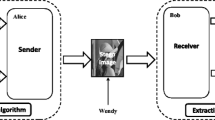Abstract
This paper proposes a novel data hiding method using pixel-value difference and modulus function for color image with the large embedding capacity(hiding 810757 bits in a 512×512 host image at least) and a high-visual-quality of the cover image. The proposed method has fully taken into account the correlation of the R, G and B plane of a color image. The amount of information embedded the R plane and the B plane determined by the difference of the corresponding pixel value between the G plane and the median of G pixel value in each pixel block. Furthermore, two sophisticated pixel value adjustment processes are provided to maintain the division consistency and to solve underflow and overflow problems. The most importance is that the secret data are completely extracted through the mathematical theoretical proof.







Similar content being viewed by others
References
Chan CK, Cheng LM (2004) Hiding data in images by simple LSB substitution. Pattern Recog 37(3):469–474
Chang CC , Tseng HW (2004) A steganographic method for digital images using side match. Pattern Recognit Lett 251431–1437
Chang KC, Huang PS, Tu TM, Chang CP (2007) Adaptive image stegannographic scheme based on tri-way pixel-value differencing. ISIC IEEE internation conference, pp 1165–1170
Chang CC, Lin CY, Fan YH (2008) Lossless data hiding for color images based on block truncation coding. Pattern Recognit 41:2347–2357
Chang CC, Chen YH, Lin CC (2009) A data embedding scheme for color images based on genetic algorithm and absolute moment block truncation coding. Soft Comput 321–331
Celik MU, Sharman G, Tekalp AM, Saber E (2002) Reversible data hiding. IEEE Int Conf Image Process 2:1646–1648
Fridrich J, Goljan M, Du R (2001) Reliable detection of LSB steganography in grayscale and color images. Proc ACM Work Multimed Secur 27–30
Goljan M, Fredrich J, Du R (2001) Distortion-free data embedding. Proceedings of 4th Infor, mation Hiding Work 27–41
Jung KH, Yoo KY (2009) Data hiding method using image interpolation. Comput Satandarda Interfaces 31(2):465–470(2)
Jung KH, Ha KJ, Yoo KY (2008) Image data hiding method based on multi-pixel differencing and LSB substitution methods. Int Conf Converg Hybrid Inf Technol 355–358
Lee YK, Chen LH (2000) High capacity image steganography model. Proc Inst Elect Eng Vis Image Sig Process 147(3):288–294
Lee TY, Shinfeng DL (2008) Dual watermark for image tamper detection and recovery. Pattern Recog 41(11):3497–3506
Li SL, Leung LC, Chan CK (2006) Performance evaluation of a steganographic method for digital imaes using side match, icicic, IS16-004
Liaw JJ, Wang WS, Chiu MY (2010) A data hiding method using secret data division and pixel value differencing. Proceedings ICGE’10 Proc 2010 Fourth INt Conf Genet Evol Comput 650–653
Lin MH, Hu YC, Chang CC (2002) Both color and gray scale secret images hiding in a color image. Int J Pattern Recog Artif Intell 16:697–713
Lin WH, Horng SJ, Kao TW, Fan P, Lee CL, Pan Y (2008) An efficient watermarking method based on significant difference of wavelet coefficient quantization. IEEE Trans Multimed 10(5):746–757
Lin Wg, Wang YR, Horng SJ (2009) A wavelet-tree-based watermarking method using distance vector of binary cluster. Expert Syst Appl 36(6):9869–9878
Liu T, Qiu ZD (2002) A DWT-based color image steganography scheme. Proc Int Conf Signal Proc 2:1568–1571
Loukhaoukha K (2012) On the security of digital watermarking scheme based on singular value decomposition and tiny genetic algorithm. J Inf Hiding Multimed Sig Process 3(2):135–141
Mandal JK, Das D (2012) Colour image steganography based on pixel value differencing in spatial domain. Int J Inf Sci Tech 2(4):83–90
Mukherjee D, Manjunath BS (1998) Color image embedding using multidimensional lattice structures. Proceedings of IEEE International Conference on Image Processing, Chicago, Illinois, USA, pp 460–464
Ni R, Ruan Q (2002) Embedding information into color images using wavelet. Proc IEEE Int Conf Comput Commun Control Power Eng 1:598–601
Petitcolas1 FAP, Anderson RJ, Kuhn MG (1999) Information hiding-a survey. Proc IEEE 87(7):1062–1078
Rosiyadi DD, Horng SJ, Fan PZ, Wang X, Khan MK, Pan Yi (2012) An efficient copyright protection scheme for e-government document images. IEEE Multimedia 19(3):62–73
Shieh CS, Huang HC, Wang FH, Pan JS (2004) Genetic watermarking based on transform-domain techniques. Pattern Recog 37(3):555–565
Tai WL, Yeh CM, Chang CC (2009) Reversible data hiding based on histogram modification of pixel differences. IEEE Trans Circ Syst Video Technol 19(6):906–910
Tian J (2003) Reversible data hiding using a difference expansion. IEEE Trans Circ Syst Video Technol 13(8):890–896
Wang Z, Bovik AC (2002) A universal image quality index. IEEE Sig Process Lett 9(3):81–84
Wang RZ, Lin CF, Lin JC (2001) Image hiding by optimal LSB substitution and genetic algorithm. Pattern Recog 34(2):671–683
Wang RZ, Lin CF, Lin JC (2006) Hiding data in images by optimal moderately significant-bit replacement. IEE Electron Lett 36(25):2069–2070
Wu DC, Tsai WH (2003) A steganographic method for images by pixel-value differencing. Pattern Recognit Lett 24(9–10):1613–1626
Wu HC, Wu NI, Tsai CS, Hwang MS (2005) Image steganographic scheme based on pixelvalue differencing and LSB replacement methods. IEE Proc Vision Image Sig Process 152(5):611–615
Xuan G, Yang C, Zhen Y, Shi YQ, Ni Z (2004) Reversible data hiding based on wavelet spread spectrum. IEEE 6th Work Multimed Sig Process 211–214
Yalman Y, Akar F, Erturk I (2010) An image interpolation based reversible data hiding method using r-weighted coding. 13th IEEE Int Conf Comput Sci Eng 346–350
Yang CH, Weng CY (2006) A steganographic method for digital images by multi-pixel differencing. Proceedings of international computer symposium, Taipei, Taiwan, R.O.C., pp 831–836
Zhang X P, Wang S Z (2004) Vulnerability of pixel-value differencing steganography to histogram analyais and modification for enhanced security. Pattern Recogn Lett 331–339
Acknowledgments
The authors are deeply grateful to the Editor-in-Chief, the associate editor and the anonymous reviewers for their valuable comments and constructive suggestions, which help to enrich the content and considerably improve the presentation of this paper.
This work was supported by the Natural Science Foundation of P.R.China (11371127, 11101164)and Natural Science Foundation of Guangdong(S2011040003243)
Author information
Authors and Affiliations
Corresponding author
Appendix A. Proof of Theorem 1
Appendix A. Proof of Theorem 1
Proof
Without loss of generality, we only prove Theorem 1 for the B plane. Now we discuss three cases for t i −B i mod 2n1.
Case 1
If
By the first formula of (4), we obtain
The
That is to say
And because
therefore, it follows from the second expression of the equation(6) that
According to the adjustment process, we have
From (13), we can derive
Case 2
Suppose that the following conditions hold
By the second formula of (4), we get
It’s not difficult to obtain
Therefor
In the following, we shall discuss two cases for\(\overline {B_{i}}-B_{i}\)
-
1)
When
$$ \overline{B_{i}}-B_{i} \in[\lfloor\frac{2^{n_{1}}+1}{2}\rfloor,\lceil\frac{2^{n_{1}+1}-1}{2}\rceil] $$(14)So we conclude from the second formula of(6)
$$B^{\prime}_{i}=\overline{B_{i}}+2^{n_{1}}.$$Then
$$B^{\prime}_{i}-B_{i}=B^{'}_{i}-\overline{B_{i}}+\overline{B_{i}}-B_{i}=2^{n_{1}}+\overline{B_{i}}-B_{i}.$$As a result, from (14), we can derive
$$B^{\prime}_{i}-B_{i}\in[\lfloor\frac{2^{n_{1}}+1}{2}\rfloor+2^{n_{1}},\lceil\frac{2^{n_{1}+1}-1}{2}\rceil+2^{n_{1}})$$$$= [\lfloor\frac{3\times2^{n_{1}}+1}{2}\rfloor, \lceil\frac{2^{n_{1}+2}-1}{2}\rceil)=[2^{n_{1}},2^{n_{1}+1})$$ -
2)
Whe
$$\overline{B_{i}}-B_{i} \in[\lceil\frac{2^{n_{1}+1}-1}{2}\rceil,\lceil\frac{3\times2^{n_{1}}-1}{2}\rceil].$$According to the first formula of (6), we know
$$B^{\prime}_{i}=\overline{B_{i}}.$$So
$$B^{\prime}_{i}-B_{i}\in[\lceil\frac{2^{n_{1}+1}-1}{2}\rceil,\lceil\frac{3\times2^{n_{1}}-1}{2}\rceil]\subset[2^{n_{1}},2^{n_{1}+1}).$$
Case 3
If
In other word
an
Consequently, from (15), we have
From the result \(B^{\prime }_{i}=\overline {B_{i}}\), we can reduce to
If \(B^{\prime }_{i}-B_{i}\subset [2^{n_{1}},2^{n_{1}+1}),\) and \(B^{\prime }_{i} <0,or B^{\prime }_{i}>255\), according to Step 7 of the embedding process, we have
Similarly, we obtain
Rights and permissions
About this article
Cite this article
Shen, S., Huang, L. & Tian, Q. A novel data hiding for color images based on pixel value difference and modulus function. Multimed Tools Appl 74, 707–728 (2015). https://doi.org/10.1007/s11042-014-2016-0
Received:
Revised:
Accepted:
Published:
Issue Date:
DOI: https://doi.org/10.1007/s11042-014-2016-0




